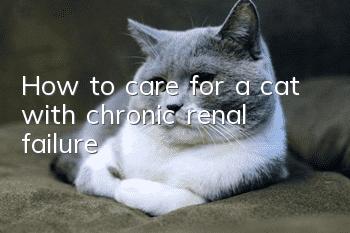How to care for a cat with chronic renal failure?

Under normal circumstances, renal failure is irreversible, so usually for cats with chronic renal failure, we can only try to prevent it from deteriorating without allowing it to return to its original state. Chronic renal failure is an unsatisfactory condition for cats and dogs. Many cats will develop uremia in the later stages and cause death. Therefore, cats suffering from chronic renal failure must be well fed and cared for.
1. Control your diet
First of all, for cats with chronic renal failure, diet control is very important. Since protein will be metabolized into uremic toxins, and the kidneys of CKD patients are no longer capable of normal metabolism, azotemia will become more serious. Controlling the protein content of the diet can reduce azotemia, thereby improving clinical symptoms such as weight loss, decreased appetite, vomiting, and lethargy. Nowadays, there are also prescription cat foods that specifically deal with renal failure, and owners can choose from them. If the cat does not accept the kidney-prescribed food, you can try a few more, rather than directly assuming that the cat does not like to eat all the prescribed foods.
2. Control potassium ions
Hypokalemia is a common problem in patients with renal failure. 20-30% of cats with renal failure often have hypokalemia. Hypokalemia will accelerate the course of the disease. There are a variety of potassium supplements to choose from. After treatment begins, the potassium level should be monitored and the potassium intake adjusted. Hyperkalemia may be more severe than hypokalemia in end-stage renal failure, however, monitoring all ions is very important in cats with renal failure.
3. Control of urinary protein
Generally, doctors will prescribe an ACE blocker for cats suffering from renal failure to control proteinuria. Maintaining protein loss in urine at a low level can slow down the course of chronic renal failure.
4. Limit phosphorus intake
For cats and dogs with kidney failure, limiting phosphorus intake is obviously helpful. At the beginning of renal failure, phosphorus intake can be limited by relying on kidney prescription feed. However, after a period of time, phosphorus intake still increases, so phosphorus-lowering drugs need to be used. Many owners and some veterinarians will Misconception that phosphorus binders can directly reduce the concentration of phosphorus in the blood, but these phosphorus binders only bind to phosphorus in food and reduce phosphorus intake. Phosphate binders are most effective when given within two hours of a meal.
5. Fluid treatment
Fluid therapy is an important way to slow down the acute symptoms of renal failure and to control animals with renal failure in the long term, especially for cats suffering from renal failure. Since the urine output of cats with renal failure will increase, a large amount of water is needed to replenish it, otherwise dehydration will occur, and dehydration will accelerate kidney damage. often waterSince the source of drinking water is not sufficient, subcutaneous injection of liquid has become necessary. Most cats have a high tolerance for subcutaneous infusion, and it is easy for owners to learn this method. As for the frequency and dosage of injection, it still depends on the cat’s condition. to make a decision.
For cats suffering from chronic renal failure, there are many things that we need to pay attention to. We try not to make mistakes in terms of diet and appropriately control the amount of certain nutrients. Of course, it is not enough to take care of ourselves. We must also use some medical methods to control the condition, so as to ensure that the cat's condition will not continue to worsen.
- A cat will die if it urinates for a few days
- Should you deworm yourself or go to a pet store?
- Are cat teasers harmful to cats?
- What should I do if my cat suffers from chronic gingivitis?
- Cat's nails are cracked with a thin layer
- Cats go crazy after eating mutton
- What does cat moss on a cat’s chin look like?
- Can cats reproduce after abdominal transmission is cured?
- What exactly is the sterilization shot for female cats?
- Can I still eat unopened cat food if it has expired?



